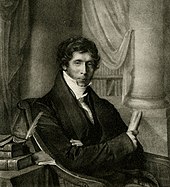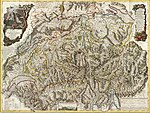Restoration and Regeneration in Switzerland
Swiss Confederation | |||||||||||||||||||||
|---|---|---|---|---|---|---|---|---|---|---|---|---|---|---|---|---|---|---|---|---|---|
| 1814–1848 | |||||||||||||||||||||
meeting of delegates from all the nineteen cantons at Zurich | 6 April 1814 | ||||||||||||||||||||
| 7 August 1815 | |||||||||||||||||||||
| November 1847 | |||||||||||||||||||||
| 12 September 1848 | |||||||||||||||||||||
| Currency | Different franc for each canton Konkordatsbatzen from 1825 | ||||||||||||||||||||
| ISO 3166 code | CH | ||||||||||||||||||||
| |||||||||||||||||||||
The periods of Restoration and Regeneration in
Restoration

When Napoleon's fall appeared imminent, the Act of Mediation was suspended in late December 1813, and lengthy discussions about future constitutions were initiated in all cantons of Switzerland.
The

At the
— though, on the other hand, de La Harpe opposed the creation of a federal state as opposed to a united Swiss republic. In addition, de La Harpe and his friend Henri Monod lobbied Emperor Alexander, who in turn persuaded the other Allied powers opposing Napoleon to recognise Vaudois and Argovian independence, in spite of Bern's attempts to reclaim them as subject lands.The official delegation had the mission of ensuring the recognition of Swiss neutrality, but their efforts were hampered by a complicated web of cantonal rivalries and diverging agendas, which went to discourage the interest of the great European powers in Swiss affairs. On 20 March, the Congress finalized a declaration on the future status of Switzerland, including the recognition of the territory of the 19 cantons of the Act of Mediation (including financial compensation for those cantons which had lost territory to newly formed ones) and the recognition of Valais, Neuchâtel and Geneva as part of Switzerland, while the Valtellina, Chiavenna and Bormio were detached from the Grisons and made part of the Kingdom of Lombardy–Venetia.
Recognition of Swiss neutrality was left undecided, and on 20 May, after
The
Cantonal constitutions were worked out independently from 1814, in general restoring the late feudal conditions of the 17th and 18th centuries. The Tagsatzung was re-organized by the Federal Treaty (Bundesvertrag) of 7 August 1815.
The Tagsatzung reintroduced the old flag consisting of a white cross on a red field, using it for the seal and coat of arms of the confederation.[1]
End of the Restoration

Following the French July Revolution in 1830, a number of large assemblies were held calling for new cantonal constitutions. As each canton had its own constitution, the assemblies in each canton addressed different specifics, but they all had two main issues. First, they called for peacefully adjusting the constitutions by adjusting the way seats in local legislatures and the Tagsatzung were allocated. In particular, they objected to what they saw as the over-representation of the cantonal capital in the government.[5] Secondly, they sought a way to amend the constitution. Very few cantons even had a way to amend or modify the constitutions, and none of them allowed citizen's initiatives to be added.
The first assembly was held near
The speeches and articles reporting on the assemblies were widely distributed and became very popular. The crowds were generally well-behaved and orderly. For example, in Wohlenschwil it was reported that they met "in unexpectedly quiet attitude with decency and perfect order".[5] Even in Aargau and St. Gallen, where the crowd marched through the streets of Aarau (Freiämtersturm) and St. Gallen, the protest march was peaceful. Following the assemblies and marches, cantonal governments quickly gave into the demands of the assemblies and amended their constitutions.
Regeneration

This "restored" state of affairs meant that the
The central demands of the liberal groups like Young Switzerland, were for abolition of
The Catholic
After the hostilities ceased, the Catholic side having the disadvantage, Modern Switzerland was formed by the first Federal Constitution.
See also
| History of Switzerland |
|---|
 |
| Early history |
|
| Old Swiss Confederacy |
|
| Transitional period |
|
| Modern history |
|
| Timeline |
| Topical |
|
|
|
Notes and references
- ^ a b The Tagsatzung re-introduced the white cross in the red field for the federal coat of arms in 1815. The commission for drafting a federal constitution on 16 May 1814 recommended the adoption of a seal of the Confederacy based on the "field sign of the old Swiss" (ratified on 4 July 1815). Article 41 (of the draft constitution): "Das Siegel der Eidgenossenschaft ist das Feldzeichen der alten Schweizer: ein weißes freistehendes Kreuz im rothen Felde, sammt der Umschrift: Schweizerische Eidgenossenschaft."
- ^ Charles Seignobos, A Political History of Europe, Since 1814, H. Holt, 1900, p. 259.
- ^ Wilhelm Oechsli, History of Switzerland 1499-1914, Cambridge University Press, 2013, p. 365.
- ^ . Encyclopædia Britannica. Vol. 26 (11th ed.). 1911.
- ^ a b Volkstage in German, French and Italian in the online Historical Dictionary of Switzerland.
- ^ a b c d e Frederick Engels, "Civil War in the Valais" contained in Marx & Engels Collected Works: Volume 3 (International Publishers: New York, 1975) p. 526.
- ^ a b c Charles Dandliker, History of Nations: Switzerland (P.F. Collier & Son Publishers: New York, 1907) p. 557.
External links
 English Wikisource has original text related to this article: Federal Treaty of 1815
English Wikisource has original text related to this article: Federal Treaty of 1815


![Coat of arms[1] of Switzerland](http://upload.wikimedia.org/wikipedia/commons/thumb/7/7c/Swiss_Federal_CoA_triangular.svg/85px-Swiss_Federal_CoA_triangular.svg.png)
